Intro
A groin hernia is a common medical condition that occurs when tissue, such as part of the intestine, protrudes through a weak spot in the abdominal muscles. This condition can be painful and may require medical attention to prevent complications. Understanding the symptoms and treatment options for groin hernias is essential for individuals who are experiencing discomfort or pain in the groin area.
The symptoms of a groin hernia can vary depending on the size of the hernia and the individual's overall health. Some people may not experience any symptoms at all, while others may feel a bulge or swelling in the groin area, which can be painful, especially when coughing, lifting heavy objects, or bending over. In some cases, the hernia may become incarcerated, which means that the tissue becomes trapped and cannot be pushed back into the abdomen. This can lead to severe pain, nausea, and vomiting, and requires immediate medical attention.
Groin hernias are more common in men than women, and they can occur at any age. However, they are more common in older adults, as the abdominal muscles weaken with age. Additionally, individuals who are overweight or have a family history of hernias are at a higher risk of developing a groin hernia. By understanding the symptoms and risk factors, individuals can take steps to prevent the development of a groin hernia and seek medical attention if they experience any discomfort or pain in the groin area.
Groin Hernia Causes And Risk Factors
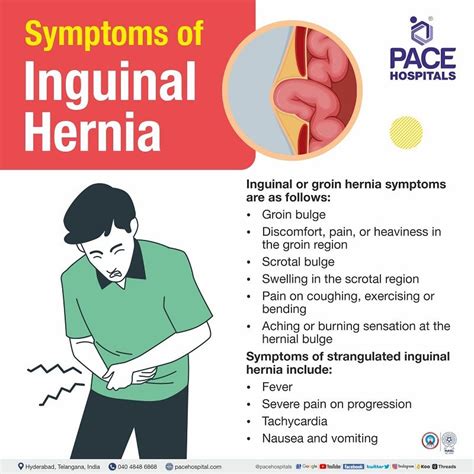
Groin hernias are caused by a combination of factors, including weak abdominal muscles, increased pressure on the abdominal cavity, and genetic predisposition. The abdominal muscles can become weak due to aging, injury, or certain medical conditions, such as chronic coughing or constipation. Additionally, individuals who are overweight or have a family history of hernias are at a higher risk of developing a groin hernia.
The risk factors for developing a groin hernia include age, gender, family history, and lifestyle factors. Men are more likely to develop a groin hernia than women, and the risk increases with age. Individuals who are overweight or have a family history of hernias are also at a higher risk. Furthermore, certain lifestyle factors, such as smoking, heavy lifting, and chronic coughing, can increase the risk of developing a groin hernia. By understanding the causes and risk factors, individuals can take steps to prevent the development of a groin hernia.
Groin Hernia Symptoms And Diagnosis
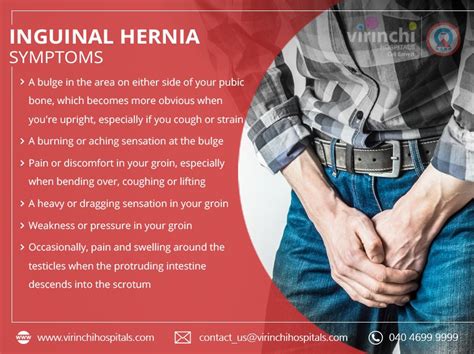
The symptoms of a groin hernia can vary depending on the size of the hernia and the individual's overall health. Some common symptoms include a bulge or swelling in the groin area, pain or discomfort in the groin area, especially when coughing, lifting heavy objects, or bending over. In some cases, the hernia may become incarcerated, which means that the tissue becomes trapped and cannot be pushed back into the abdomen. This can lead to severe pain, nausea, and vomiting, and requires immediate medical attention.
To diagnose a groin hernia, a doctor will perform a physical examination and take a medical history. The doctor will examine the groin area to check for a bulge or swelling and may ask the individual to cough or strain to see if the hernia becomes more prominent. In some cases, imaging tests, such as an ultrasound or CT scan, may be ordered to confirm the diagnosis and rule out other conditions.
Groin Hernia Treatment Options
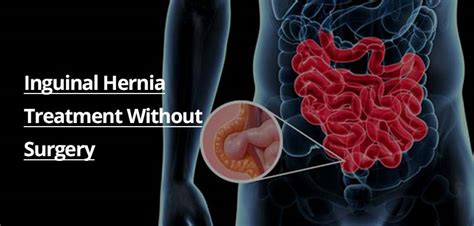
There are several treatment options for groin hernias, including watchful waiting, surgery, and lifestyle changes. Watchful waiting involves monitoring the hernia for any changes or complications, and is usually recommended for small, asymptomatic hernias. Surgery is usually recommended for larger hernias or those that are causing symptoms. There are two types of surgery: open repair and laparoscopic repair. Open repair involves making a large incision in the abdomen to repair the hernia, while laparoscopic repair involves making several small incisions and using a laparoscope to repair the hernia.
Lifestyle changes can also help to manage the symptoms of a groin hernia and prevent complications. These include maintaining a healthy weight, avoiding heavy lifting, and managing chronic coughing or constipation. Additionally, wearing a hernia truss or belt can help to provide support and relieve discomfort.
Groin Hernia Surgery
Groin hernia surgery is usually performed under general anesthesia, and the type of surgery will depend on the size and location of the hernia. Open repair is usually recommended for larger hernias, while laparoscopic repair is usually recommended for smaller hernias. The surgery typically involves making an incision in the abdomen, pushing the hernia back into the abdomen, and repairing the weak spot in the abdominal muscles.Groin Hernia Recovery
After surgery, individuals will need to rest and avoid heavy lifting or strenuous activities for several weeks. Pain medication may be prescribed to manage discomfort, and individuals may need to wear a hernia truss or belt to provide support. It's also important to follow a healthy diet and exercise regularly to promote healing and prevent complications.Groin Hernia Complications And Prevention

There are several complications that can occur with groin hernias, including incarceration, strangulation, and recurrence. Incarceration occurs when the tissue becomes trapped and cannot be pushed back into the abdomen, while strangulation occurs when the blood supply to the tissue is cut off. Recurrence occurs when the hernia returns after surgery.
To prevent complications, it's essential to seek medical attention if symptoms persist or worsen over time. Additionally, maintaining a healthy weight, avoiding heavy lifting, and managing chronic coughing or constipation can help to prevent the development of a groin hernia. Wearing a hernia truss or belt can also help to provide support and relieve discomfort.
Groin Hernia In Children
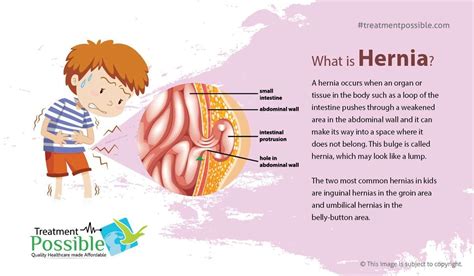
Groin hernias can occur in children, and are usually congenital, meaning they are present at birth. The symptoms of a groin hernia in children are similar to those in adults, and may include a bulge or swelling in the groin area, pain or discomfort in the groin area, especially when coughing, lifting heavy objects, or bending over.
The treatment for groin hernias in children usually involves surgery, and the type of surgery will depend on the size and location of the hernia. In some cases, watchful waiting may be recommended for small, asymptomatic hernias. However, it's essential to seek medical attention if symptoms persist or worsen over time, as complications can occur if left untreated.
Groin Hernia In Women

Groin hernias are less common in women than men, but can still occur. The symptoms of a groin hernia in women are similar to those in men, and may include a bulge or swelling in the groin area, pain or discomfort in the groin area, especially when coughing, lifting heavy objects, or bending over.
The treatment for groin hernias in women usually involves surgery, and the type of surgery will depend on the size and location of the hernia. In some cases, watchful waiting may be recommended for small, asymptomatic hernias. However, it's essential to seek medical attention if symptoms persist or worsen over time, as complications can occur if left untreated.
Groin Hernia Repair
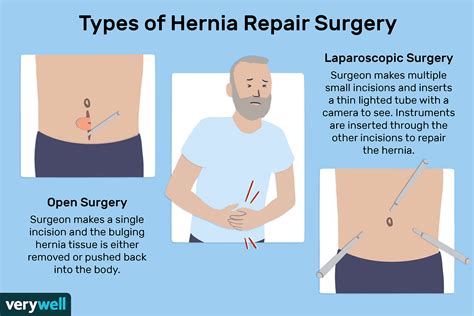
Groin hernia repair involves surgically repairing the weak spot in the abdominal muscles. There are two types of surgery: open repair and laparoscopic repair. Open repair involves making a large incision in the abdomen to repair the hernia, while laparoscopic repair involves making several small incisions and using a laparoscope to repair the hernia.
The benefits of groin hernia repair include relief from symptoms, prevention of complications, and improved quality of life. However, there are also risks and complications associated with surgery, including infection, bleeding, and recurrence.
Groin Hernia Prevention
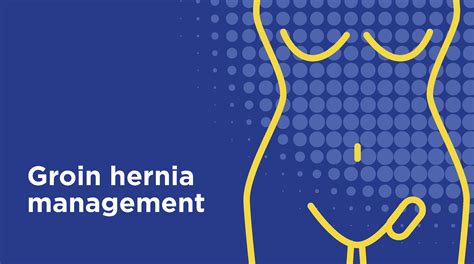
There are several ways to prevent groin hernias, including maintaining a healthy weight, avoiding heavy lifting, and managing chronic coughing or constipation. Additionally, wearing a hernia truss or belt can help to provide support and relieve discomfort.
It's also essential to seek medical attention if symptoms persist or worsen over time, as complications can occur if left untreated. By understanding the causes and risk factors, individuals can take steps to prevent the development of a groin hernia and seek medical attention if they experience any discomfort or pain in the groin area.
What are the symptoms of a groin hernia?
+The symptoms of a groin hernia include a bulge or swelling in the groin area, pain or discomfort in the groin area, especially when coughing, lifting heavy objects, or bending over.
How is a groin hernia diagnosed?
+A groin hernia is diagnosed through a physical examination and medical history. Imaging tests, such as an ultrasound or CT scan, may also be ordered to confirm the diagnosis and rule out other conditions.
What are the treatment options for a groin hernia?
+The treatment options for a groin hernia include watchful waiting, surgery, and lifestyle changes. Surgery is usually recommended for larger hernias or those that are causing symptoms.
Can groin hernias be prevented?
+Yes, groin hernias can be prevented by maintaining a healthy weight, avoiding heavy lifting, and managing chronic coughing or constipation. Wearing a hernia truss or belt can also help to provide support and relieve discomfort.
What are the complications of a groin hernia?
+The complications of a groin hernia include incarceration, strangulation, and recurrence. Incarceration occurs when the tissue becomes trapped and cannot be pushed back into the abdomen, while strangulation occurs when the blood supply to the tissue is cut off. Recurrence occurs when the hernia returns after surgery.
In final thoughts, groin hernias are a common medical condition that can be painful and may require medical attention to prevent complications. By understanding the symptoms, causes, and treatment options, individuals can take steps to prevent the development of a groin hernia and seek medical attention if they experience any discomfort or pain in the groin area. We invite you to share your thoughts and experiences with groin hernias in the comments below, and to share this article with anyone who may be experiencing symptoms or seeking more information on this topic.
